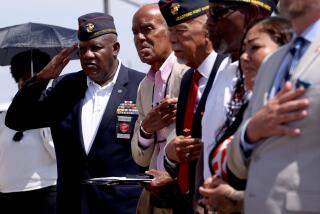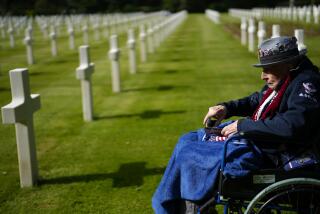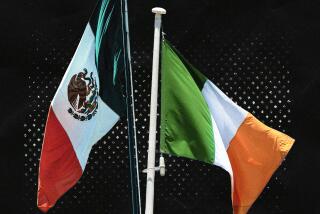Barney F. Hajiro dies at 94; World War II Medal of Honor recipient
Barney F. Hajiro, whose heroic actions as a World War II Army private during the rescue of the so-called Lost Battalion and in two other fierce battles in eastern France earned him a belated Medal of Honor nearly six decades later, has died. He was 94.
Hajiro, who had been in declining health, died Jan. 21 at a nursing and rehabilitation center in Honolulu, said his son, Glenn.
The Hawaiian-born son of Japanese immigrants, Hajiro was a member of the 442nd Regimental Combat Team, the highly decorated Army unit activated in early 1943 and made up mostly of Japanese Americans.
Hajiroâs Medal of Honor was awarded for his heroism during three separate days in the vicinity of Bruyeres and Biffontaine in October 1944.
On Oct. 19, he was a sentry on top of an embankment when, as chronicled in his Medal of Honor citation, he assisted Allied troops attacking a house 200 yards away by exposing himself to enemy fire and directing fire at an enemy strong point. He also helped the unit on his right by firing his automatic rifle and killing or wounding two enemy snipers.
On Oct. 22, Hajiro and a fellow soldier concealed themselves in an outpost security position about 50 yards to the right front of their platoon and ambushed an 18-man, heavily armed, enemy patrol: They killed two, wounded one and took the rest as prisoners.
Then on Oct. 29, during the rescue of the enemy-surrounded 141st Texas Regiment â the Lost Battalion â Hajiro initiated an attack up what was dubbed Suicide Hill by running forward about 100 yards under fire.
âHe then advanced ahead of his comrades about 10 yards, drawing fire and spotting camouflaged machine gun nests,â his citation reads. âHe fearlessly met fire with fire and single-handedly destroyed two machine gun nests and killed two enemy snipers. As a result of Private Hajiroâs heroic actions, the attack was successful.â
Hajiro, who was shot in the shoulder and wrist and barred from further combat duty, originally received a Distinguished Service Cross, the Armyâs second-highest award for combat valor.
But that changed after Sen. Daniel K. Akaka (D-Hawaii) sponsored an amendment to the 1996 Defense Authorization Act that ordered the Army to reassess the records of World War II veterans of Asian ancestry who had received Distinguished Service Crosses to see if they deserved the Medal of Honor.
Akaka was concerned that racial prejudice against Japanese Americans during the war, a time when thousands of Japanese Americans were relocated to internment camps, prevented them from receiving the highest award for valor in combat.
âThe fact that the [Japanese-American 100th Infantry Battalion and 442nd Regimental Combat Team] saw such fierce and heavy combat, yet received only one Medal of Honor award, and then only posthumously and due to congressional intervention, raised serious questions about the fairness of the award process at the time,â Akaka told the Associated Press in 2000.
At a White House ceremony that year, Hajiro and 21 other Asian Americans who had served during World War II were awarded Medals of Honor.
Hajiro and Sen. Daniel Inouye (D-Hawaii) were among the seven recipients present at the ceremony. The others were honored posthumously.
âThey risked their lives above and beyond the call of duty, and in doing so, they did more than defend America,â President Clinton said at the ceremony. âIn the face of painful prejudice, they helped to define America at its best.â
Glenn Hajiro, who attended the ceremony with other family members, said his father âwas very proud. He told me, âIâm receiving this medal for all the boys,â all the guysâ with whom he fought.
Hajiro, who had been awarded the Military Medal by the British government for his role in rescuing the Lost Battalion in 1948, was awarded the French Legion of Honor in 2004.
âWe rescued the Texas boys,â he told the Honolulu Star-Bulletin after receiving the award aboard a French military ship docked in Honolulu Harbor. âIt was teamwork, not individual. We all fought in the battle.â
The second of nine children, Hajiro was born Sept. 16, 1916, in Puunene on Maui. He left school to work in the sugar cane fields and later worked as a stevedore in Honolulu before the Japanese attack on Pearl Harbor on Dec. 7, 1941.
After he was drafted, Hajiro did menial labor in an engineering battalion before volunteering for the 442nd Regimental Combat Team. After his discharge, he worked in security at the Pearl Harbor Naval Shipyard and later at Honolulu International Airport.
In addition to his son, Hajiro is survived by his wife, Esther; two brothers, Tokuro Hajiro and Umeo Hashiro; a sister, Pearl Yoshikawa; and a grandson.
More to Read
Start your day right
Sign up for Essential California for the L.A. Times biggest news, features and recommendations in your inbox six days a week.
You may occasionally receive promotional content from the Los Angeles Times.






